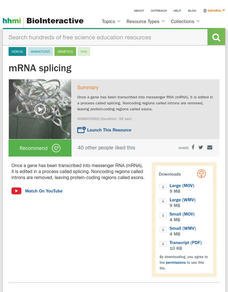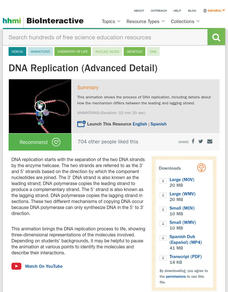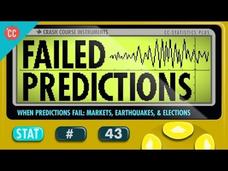American Chemical Society
The Periodic Table Table
You'd be hard pressed to find someone more dedicated to the periodic table than Theodore Gray. A video lesson interviews him as he describes his passion and his creation. The installment of a larger series on reactions shows Gray's table...
American Chemical Society
The Race to Invent the Periodic Table
Mendeleev was a visionary, providing a tool to predict things we didn't even know about yet! He was the first to recognize the pattern in the properties of elements and create the skeleton of the chart that we know today as the periodic...
American Chemical Society
Burning Ice from the Ocean Floor
Ice burns on the ocean floor as climate change continues. That's right ... ice burns! It turns out the burning is actually methane trapped in the crystalline structure of the ice. The video presentation is part of a larger series...
American Chemical Society
How Do Airbags Work?
Explore the chemical reaction that may just save your life! An episode of a comprehensive series covering chemical reactions discusses what triggers the inflation of airbags during a crash. Initiated by an accelerometer, a combustion...
American Chemical Society
Does Melatonin Do Anything?
Melatonin is a supplement that is gaining popularity. The jury is still out, however, on its effectiveness according to the video presentation that is part of a larger reaction series. The narrator discusses the different factors that...
American Chemical Society
How Milk Becomes Cheese
That sour milk in your fridge is a long way from becoming cheese...or is it? The original purpose of making cheese was simply to preserve the nutritional content of milk. Using an informative video from a larger playlist exploring...
American Chemical Society
Chameleons Are Masters of Nanotechnology
The oddball reptiles, chameleons, can teach animal lovers a little something about nanotechnology. Viewers peel away the layers of the chameleon skin to discover the different types of chromatophores using an episode of a larger series...
American Chemical Society
How Seashells Are Made
What do chalk and seashells have in common? They are both primarily calcium carbonate! Learn how sea creatures use crystalline structure to their advantage as they build their shell homes. An installment of a larger series on reactions...
Howard Hughes Medical Institute
Building Blocks of DNA
How many times can you say deoxyribonucleic acid fast? Viewers learn the components that create DNA using a video representation. The narrator introduces learners to adenine, guanine, cytosine, and thymine and how they create the...
Howard Hughes Medical Institute
Damage to DNA Leads to Mutation
While our bodies have incredible capabilities to repair damage, some mutations accumulate and lead to disease. Follow the life of a DNA mutation using a computer-generated animation. The narrator explains the impact of radiation,...
Howard Hughes Medical Institute
mRNA Splicing
Edit, copy, and paste are not just for word processing! Learn how a gene transcribes into mRNA and then translates into a protein. Editing is the first step and is the focus of the animation as it demonstrates how special enzymes remove...
Howard Hughes Medical Institute
DNA Packaging
One thing that all cells have in common is the DNA in their nucleus. An animation demonstration models how six feet of DNA fits in each and every nucleus of each cell. The content includes information about the components of DNA and how...
Howard Hughes Medical Institute
Polymerase Chain Reaction
Just when things get heated up, they cool down again! Using an animation, a video presentation demonstrates the process of polymerase chain reaction. A narrator describes the temperature changes and the process that ensues as...
Howard Hughes Medical Institute
DNA Replication (Schematic)
Explore the beginnings of the theory to explain DNA replication using an eye-catching animation. Scholars view a simple rendition of DNA replication with an explanation of the first theories suggesting its existence. The animation shows...
Howard Hughes Medical Institute
DNA Replication (Basic Detail)
Animations are powerful tools for seeing things the eye cannot! A thorough lesson demonstration models DNA replication with a 3-D animation. The video demonstrates how enzymes first separate the original DNA and then copy the resulting...
Howard Hughes Medical Institute
DNA Replication (Advanced Detail)
Don't leave anything to the imagination! Use an animation to demonstrate the replication of DNA. The animation shows how the double helix separates and then begins copying nucleotides to create a copy.
Corbett Maths
Converting Imperial Capacity
Do your classes know how many pints are in the gallon of milk in their
fridges? A video presentation explains the conversion factor between
pints and gallons and demonstrates how to convert between the two
measurements. Learners then...
Crash Course
When Predictions Succeed: Crash Course Statistics #44
Statistics show people eat more berries when the weather is nice. Young entrepreneurs learn how stores use statistics like this to plan their advertising and sales strategies. The narrator uses various examples to show how important...
Corbett Maths
Converting Metric Units for Volume
The capacity for learning is great. Develop the conversion factors for metric capacities with a video presentation. The lesson narrator describes the origin of the factors and then shows how to convert between metric volume units.
Corbett Maths
Metric to Imperial Mass
Lift the weight of teaching unit conversions! A video presentation demonstrates conversions between kilograms, pounds, and grams. The narrator explains the conversion factors and then completes several examples of each.
Corbett Maths
Converting Imperial Length
What would you think if someone told you the speed they can run is 7,920? Not possible right? It is if it's 7,920 feet per mile! Young scholars view a set of examples showing how to make conversions between the standard units of length....
Crash Course
When Predictions Fail: Crash Course Statistics #43
The world relies on statistics for important predictions like earthquakes, volcano eruptions, and winners of presidential elections. Examine some popular failed predictions and identify their flaws while watching the 43rd installment of...
SciShow
Were the Planets Always in the Same Order?
Our solar system is just like the other solar systems, right? It seems that isn't quite true, but the differences give scientists information about the movement of the planets. An episode of the SciShow Space series describes the physics...
PBS
When Apes Conquered Europe
Where are they now? Apes are humans' closest evolutionary ancestor, yet they only live in small areas in Africa and Asia. Learn how their geography changes with evolution in a video lesson from the PBS Eon series.























